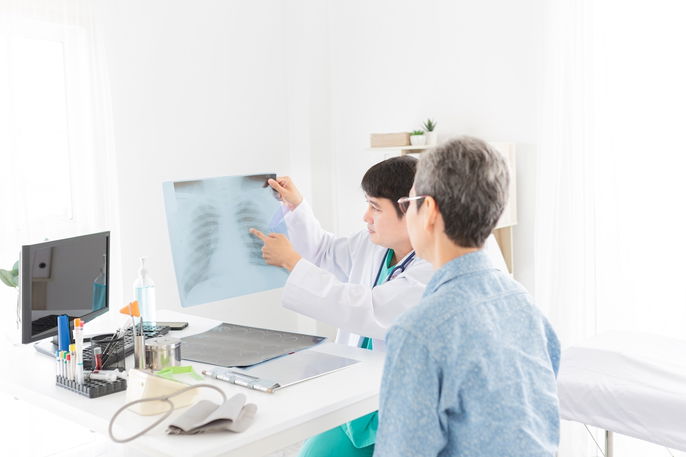Broken ribs are characterized by a crack or a total or partial fracture in the ribs. It can affect one or multiple ribs, and can occur due to direct trauma to the area. Symptoms fo broken ribs include intense pain that worsens with breathing or moving, shortness of breath, swelling and bruising in the area.
The purpose of the ribs is to protect the organs found in the chest and upper abdomen, like the lungs, heart, kidneys, thymus, trachea and esophagus, as well as help with the movements needed to breathe. With broken ribs, these organs can be injuries, and breathing can also be impacted.
Treatment for broken ribs should be guided by an orthopedic surgeon, who may prescribe analgesics to relieve pain, as well as rest and physiotherapy. Surgery is only indicated in some cases, where there is no improvement with initial treatment, or when the fracture causes serious injuries, including perforation of the lungs or other organs in the chest.

Common symptoms
The main symptoms of broken ribs are:
- Severe chest pain, which worsens with breathing, coughing or when trying to twist the torso
- Difficulty breathing
- Bruising or swelling in the chest
- Visible deformity over the ribs
- Pain or noises during palpation of the chest.
Broken ribs that do not involve bone separation or irregular edges tend to heal on their own without any major interventions.
However, broken ribs are considered to be a serious condition when bones become separated or have irregular edges, as these types are more likely to cause a lung perforation (known as a pneumothorax) or other organ injury.
Therefore, if you experience symptoms such as difficulty taking a deep breath, pressure in the chest, chest pain, coughing up phlegm or blood, or fever, you should proceed to the nearest emergency room for assessment and treatment.
Confirming a diagnosis
The diagnosis of a broken rib is made by a family doctor or orthopedic surgeon, who will start by evaluating the patient's symptoms and recent history of accidents or trauma, then proceeding to a physical assessment.
If the doctor suspects a broken rib, he or she will order imaging test like a chest X-ray, CT scan, MRI, ultrasound or a bone scan. These tests will help to visualize the injury and identify the side, region, number of ribs and severity of the fracture.
Imaging tests can also help allow the doctor to assess for any complications such as bleeding, a collapsed lung, a pulmonary contusion or injuries to the aorta, for example.
Possible causes
The main causes of broken ribs are:
- Car, motorcycle or bike accidents
- Falls or blows to the chest
- Osteoporosis
- Stabbing in the chest (knives, foreign objects)
- Contact sports, such as football, judo, jiu-jitsu, karate, hockey or basketball
- Intense coughing
- Repetitive chest movements
- Tumor or metastasis in the bones
Fractures are more common in young people, but can also happen in the elderly due to falls.
In babies or children, ribs are more elastic and flexible than in adults, making rib fractures less common. Therefore, when a child has a broken rib, it may be a sign of physical abuse, such as repeated pushing or direct trauma to the chest.
Treatment options
The treatment for broken ribs should be guided by a family doctor or orthopedic doctor, and can vary depending on the severity of the fracture and the number of ribs affected.
Generally, for simple fractures in just one rib, the best treatment approach is rest, ice and analgesics like acetaminophen or ibuprofen. In some cases, an intercostal nerve block may be injected in the area to help control pain.
It is not recommended to tie anything around the chest or to wear a brace because it can make it difficult for the lungs to expand. This can lead to further complications, like pneumonia.
In cases where symptoms do not improve with conservative treatment, or if the fracture causes heavy bleeding or other organ injuries, surgical interventions may be needed.
Physiotherapy also plays an important role in recovery, as specific exercises can help to maintain muscle strength and range of motion in the chest. Breathing exercises can also help to promote full chest expansion.
Daily care
When recovering from broken ribs, you should consider the following measures:
- Avoid sleeping on your side or on your stomach.The ideal position is to sleep on your back with a pillow under your knees and another under your head.
- Avoid driving in the first few weeks after the fracture, as reflexes will be decreased due to limited torso movement.
- Hold a pillow or blanket against your chest when coughing or sneezing to reduce pain.
- If you feel chest pain, sit in a chair and lean forward to promote breathing.
- Do not engage in sports or physical activity until approved by your doctor.
- Avoid staying in the same position for a long time (except while sleeping);
- Avoid lifting weights, doing push-ups, pushing or pulling objects;
- Avoid drinking alcohol and smoking to promote optimal healing.
You should also perform breathing exercises as guided by your doctor every 2 hours, as these can promote recovery as well as prevent lung infections or a lung collapse. Most times, broken ribs will heal within 1 to 2 months.






























